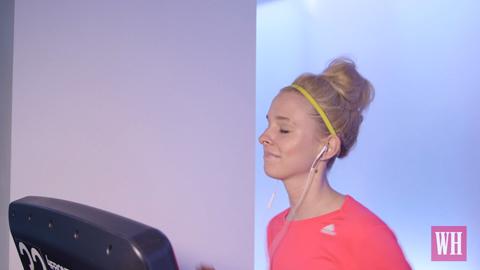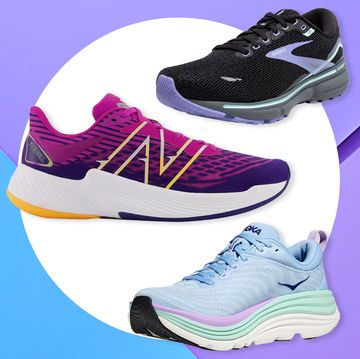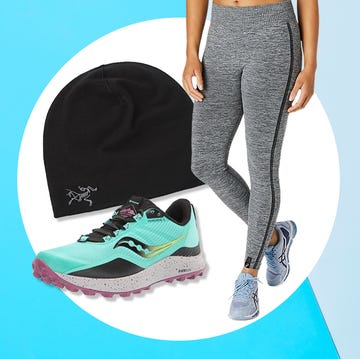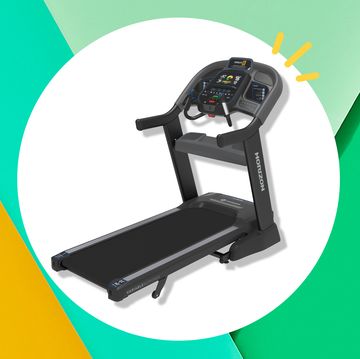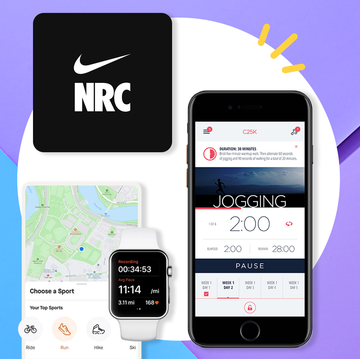Here’s the thing about running: If you want to become a runner, the only thing you really have to do is, well, run. One step, two steps, three steps, voilà: You’re a runner!
Easier said than done, right? "Sometimes the hardest part of a run is the first step,” says Corinne Fitzgerald, a coach at New York City’s Mile High Run Club. Especially in the winter when it’s cold, or when you want to finish Stranger Things on Netflix, or when you have a fresh blowout. You can always find an excuse to skip a workout. So “lace your shoes up quick and don't give yourself too much time to overthink—less time to talk yourself out of it! No one ever regretted going for a run!"
But if you want to make running a consistent workout or you’ve decided that this is finally the year you’ll go from couch to 5K, half-marathon, whatever, there are a few more steps you’ll need to take. Don’t worry—they’re all really easy, and by the end of the month, you’ll feel like an old pro at pounding the pavement.
1. Get fitted for running shoes.
You don’t just want to get those sick sneakers you saw on Instagram, or the kicks your friend swears by; you need to find out what shoes are going to work for your feet. “Go to a running shoe store that specializes in running shoes,” says David Siik, founder of the Precision Running program at Equinox. At these stores, you can find out information about your gait, your foot type, and more. “Try on at least three different pairs of shoes, and although there is a lot of analysis and advice that the store can give, don’t devalue the importance of simply choosing the shoe that just feels the best.”
2. Set small goals.
Maybe you want to run a marathon. Or maybe you want to be able to run for an hour at a time. Those are great, but if you’re starting from scratch, the smaller, realistic, and more achievable goals are the ones that will keep you motivated and on track to meet the bigger goals, says Amanda Nurse, an elite runner and coach at Heartbreak Hill Running Company in Boston. “Small goals should be specific, have a short-term time frame, and be just slightly outside of your comfort zone.” Each time you meet a new goal (and set a new PR!), you’ll be inspired to tackle the next, whether it’s another mile or just another five minutes.
3. Take a running class.
If the idea of running alone sounds intimidating or, worse, boring to you, try one of the treadmill classes that are popping up everywhere. “Even though running is simple—put one foot in front of the other right?—it's hard to know what to do if you're just getting into running,” says Fitzgerald. “Taking a class with knowledgeable instructors can give you some insight on what to do, why you're doing it, and how to do it in the best and safest way."
4. Download a running app.
There are a ton out there: Nike Run Club, Strava, MapMyRun, RunKeeper, the list goes on. Whether you care about pace or mileage or not, using one as a social network can be seriously motivating—and you can thank everyone else who uses them for that. A recent study examined data from 1.1 million people who automatically shared their running information on a social media network over five years and discovered that for every extra half mile someone ran, their peers also ran a half mile more than usual. Translation: Running can actually be contagious, so follow in those strangers’ footsteps!
5. Join a running club.
Make working out a social experience and you’re more likely to stick with it. You can find free running clubs at stores like Lululemon or Nike, but most cities have a wealth of options. “Finding the right group takes a little shopping around, but social media is actually a pretty good place to start, because you can get a good picture of how different groups structure themselves,” says Jessie Zapotechne, the founder of Girls Run NYC. The benefits of joining a group can go beyond just motivating you to keep running, Zapotechne says. “We’ve found that women have created lasting relationships with one another through the group and also use the space to network, skill share, and also raise awareness around women's issues.”
If you've run on a treadmill in your life, you'll be able to relate to these thoughts every woman has had on the treadmill:
6. Find a running buddy.
Most things are better with a buddy, and running is no exception. People who worked out with friends (or a spouse) enjoyed exercising more than those who worked out alone, according to a research from the University of Southern California. Even better: People who got sweaty with someone they thought was fitter than them upped their workout time and intensity by up to 200 percent, a study from Kansas State University found.
7. But don't compare yourself to other runners.
There are a lot of runners out there, but only one pace, time, or distance matters: yours. “Comparison could be the single most debilitating thing you could inflict upon yourself as a runner,” says Karli Alvino, a coach at Mile High Run Club. “Everyone is born with different genes, and equal effort does not always yield equal results—appreciate and congratulate yourself for your own unique abilities and successes,” says Alvino. Plus, trying to keep up with other runners who may be naturally faster or just more experienced can actually lead to your own injuries. “Set achievable goals to work toward and celebrate the process,” says Alvino. “Slow progress is still progress!”
8. Do other workouts, too.
“Many runners often neglect strength training as they start to run, but just a few simple lower-body strength training moves a couple times a week can make a huge difference in how your body reacts to running,” says Scott Carvin, a coach at Mile High Run Club. He recommends simple bodyweight exercises like lunges, squats, step-ups, and glute bridges. “Not only will you be strengthening the muscles in your legs, but the ligaments and tendons as well, which will be put under much more stress than your body will be accustomed to.” That’s why most running training plans—even a couch to 5K—include cross-training days; the stronger you are overall, the better a runner you’ll be (and the less likely you’ll experience injuries, too!).
9. Don't forget injury prevention/recovery work.
Elite athletes spend as much time (if not more!) doing this as they do actually running. “If you’re feeling sore after a long run, go for a walk—it’s important to continue to stay active and keep your body moving, even if you’re not running,” says long-distance runner Ryan Hall. “Use a Fitbit device to reach your step goals even on days off.” This is especially important for new runners. “My advice is to make it part of your plan from the beginning rather than a supplemental thing” says Silk. “Create a ritual of stretching or regeneration work that you always do before and after you do any run, no matter how long or short the run is. Good habits start from the beginning.”
10. Track your progress.
Watching the miles add up can be motivating, especially if you’re starting from zero. “I’m old school in that I like to actually write mileage on a calendar on my fridge and see the month in front of me,” says Zapotechne. “It feels good to me to be able to check off a day and say ‘I ran today.’ On the flip side, to look at my calendar and see that three days have gone by and I didn't run, lights a fire for me to get out there.”
11. Stick with it.
Here’s a little secret about running: It never gets easier, you just get better at it. But the way to make it feel a little easier is to be consistent with your training. That means you shouldn’t expect to run, say, five miles without working up to it. “You want to slowly build your mileage and allow your body—your muscles, bones, ligaments, tendons—to adapt to the pounding and repetitive motion of running,” says Nurse. “A good rule of thumb: Increase your weekly mileage only by a mile or two each week. Any more, you increase your risk of injury. On the flip side, make sure you take a day off (or two) per week to allow your body to recover from those long runs and workouts. Same goes if you take some time off—don’t expect to jump right back into higher mileage; dial things back a bit and work your way back up to avoid injury.


